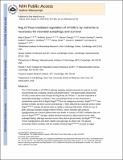| dc.contributor.author | Efeyan, Alejo | |
| dc.contributor.author | Zoncu, Roberto | |
| dc.contributor.author | Chang, Steven | |
| dc.contributor.author | Gumper, Iwona | |
| dc.contributor.author | Snitkin, Harriet | |
| dc.contributor.author | Kirak, Oktay | |
| dc.contributor.author | Sabatini, David D. | |
| dc.contributor.author | Wolfson, Rachel Laura | |
| dc.contributor.author | Sabatini, David | |
| dc.date.accessioned | 2015-04-23T17:29:37Z | |
| dc.date.available | 2015-04-23T17:29:37Z | |
| dc.date.issued | 2012-12 | |
| dc.date.submitted | 2012-02 | |
| dc.identifier.issn | 0028-0836 | |
| dc.identifier.issn | 1476-4687 | |
| dc.identifier.uri | http://hdl.handle.net/1721.1/96745 | |
| dc.description.abstract | The mechanistic target of rapamycin complex 1 (mTORC1) pathway regulates organismal growth in response to many environmental cues, including nutrients and growth factors. Cell-based studies showed that mTORC1 senses amino acids through the RagA–D family of GTPases (also known as RRAGA, B, C and D), but their importance in mammalian physiology is unknown. Here we generate knock-in mice that express a constitutively active form of RagA (RagA[superscript GTP]) from its endogenous promoter. RagA[superscript GTP/GTP] mice develop normally, but fail to survive postnatal day 1. When delivered by Caesarean section, fasted RagA[superscript GTP/GTP] neonates die almost twice as rapidly as wild-type littermates. Within an hour of birth, wild-type neonates strongly inhibit mTORC1, which coincides with profound hypoglycaemia and a decrease in plasma amino-acid concentrations. In contrast, mTORC1 inhibition does not occur in RagA[superscript GTP/GTP] neonates, despite identical reductions in blood nutrient amounts. With prolonged fasting, wild-type neonates recover their plasma glucose concentrations, but RagA[superscript GTP/GTP] mice remain hypoglycaemic until death, despite using glycogen at a faster rate. The glucose homeostasis defect correlates with the inability of fasted RagA[superscript GTP/GTP] neonates to trigger autophagy and produce amino acids for de novo glucose production. Because profound hypoglycaemia does not inhibit mTORC1 in RagA[superscript GTP/GTP] neonates, we considered the possibility that the Rag pathway signals glucose as well as amino-acid sufficiency to mTORC1. Indeed, mTORC1 is resistant to glucose deprivation in RagA[superscript GTP/GTP] fibroblasts, and glucose, like amino acids, controls its recruitment to the lysosomal surface, the site of mTORC1 activation. Thus, the Rag GTPases signal glucose and amino-acid concentrations to mTORC1, and have an unexpectedly key role in neonates in autophagy induction and thus nutrient homeostasis and viability. | en_US |
| dc.description.sponsorship | National Institutes of Health (U.S.) (Grant R01 CA129105) | en_US |
| dc.description.sponsorship | National Institutes of Health (U.S.) (Grant R01 CA103866) | en_US |
| dc.description.sponsorship | National Institutes of Health (U.S.) (Grant R37 AI047389) | en_US |
| dc.description.sponsorship | American Federation for Aging Research | en_US |
| dc.description.sponsorship | Starr Cancer Consortium | en_US |
| dc.description.sponsorship | David H. Koch Institute for Integrative Cancer Research at MIT (Frontier Research Program) | en_US |
| dc.description.sponsorship | Ellison Medical Foundation | en_US |
| dc.language.iso | en_US | |
| dc.publisher | Nature Publishing Group | en_US |
| dc.relation.isversionof | http://dx.doi.org/10.1038/nature11745 | en_US |
| dc.rights | Creative Commons Attribution-Noncommercial-Share Alike | en_US |
| dc.rights.uri | http://creativecommons.org/licenses/by-nc-sa/4.0/ | en_US |
| dc.source | PMC | en_US |
| dc.title | Rag GTPase-mediated regulation of mTORC1 by nutrients is necessary for neonatal autophagy and survival | en_US |
| dc.title.alternative | Regulation of mTORC1 by the Rag GTPases is necessary for neonatal autophagy and survival | en_US |
| dc.type | Article | en_US |
| dc.identifier.citation | Efeyan, Alejo, Roberto Zoncu, Steven Chang, Iwona Gumper, Harriet Snitkin, Rachel L. Wolfson, Oktay Kirak, David D. Sabatini, and David M. Sabatini. “Regulation of mTORC1 by the Rag GTPases Is Necessary for Neonatal Autophagy and Survival.” Nature 493, no. 7434 (December 23, 2012): 679–683. | en_US |
| dc.contributor.department | Massachusetts Institute of Technology. Department of Biology | en_US |
| dc.contributor.department | Whitehead Institute for Biomedical Research | en_US |
| dc.contributor.department | Koch Institute for Integrative Cancer Research at MIT | en_US |
| dc.contributor.mitauthor | Wolfson, Rachel Laura | en_US |
| dc.contributor.mitauthor | Sabatini, David M. | en_US |
| dc.relation.journal | Nature | en_US |
| dc.eprint.version | Author's final manuscript | en_US |
| dc.type.uri | http://purl.org/eprint/type/JournalArticle | en_US |
| eprint.status | http://purl.org/eprint/status/PeerReviewed | en_US |
| dspace.orderedauthors | Efeyan, Alejo; Zoncu, Roberto; Chang, Steven; Gumper, Iwona; Snitkin, Harriet; Wolfson, Rachel L.; Kirak, Oktay; Sabatini, David D.; Sabatini, David M. | en_US |
| dc.identifier.orcid | https://orcid.org/0000-0002-9535-7664 | |
| dc.identifier.orcid | https://orcid.org/0000-0002-1446-7256 | |
| mit.license | OPEN_ACCESS_POLICY | en_US |
| mit.metadata.status | Complete | |
